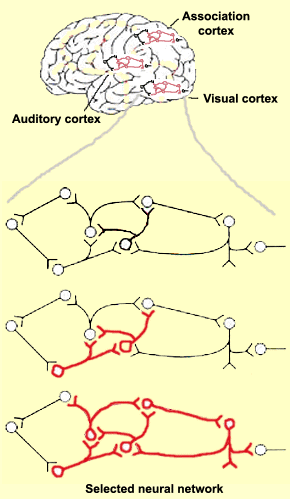How the Brain Creates New Neural Pathways

We always talk about NLP, NAC, and NLC so today I decided we would get to the core of simplicity to address the complexity.
There are a variety of reasons that drive the creation of neurons linking together in new ways. A few drivers of the way existing neurons may begin to link in a new manner might be through focused learning of new information or situations we are exposed to. Another could be an area of the brain damaged by an illness such as a stroke might drive the injured part of the brain’s essential functions to be taken over by a healthy area (usually an area close in proximity), mental illness, but there are a multitude of reasons it can happen.
Here is an example of how it might happen. You might decide to learn that new language that you’ve been meaning to for the last 10 years. As you study the language neurons housed in the area of your brain that’s storing your native language would send electrical messengers down the axons to the cell’s center (soma) where it is then routed to a particular group of connected dendrites which would then release a chemical messenger to the new targeted group of neurons that are located next to it. New neural pathways begin to be formed to acquire and store the new language. These new pathways become stronger the more they are used, causing the likelihood of new long-term connections and memories.
PLASTICITY IN NEURAL NETWORKS

Every time you learn something, neural circuits are altered in your brain. These circuits are composed of a number of neurons (nerve cells) that communicate with one another through special junctions called synapses.
When you learn something, it is actually these synapses whose efficiency increases, thus facilitating the passage of nerve impulses along a particular circuit. For example, when you are exposed to a new word, you have to make new connections among certain neurons in your brain to deal with it: some neurons in your visual cortex to recognize the spelling, others in your auditory cortex to hear the pronunciation, and still others in the associative regions of the cortex to relate the word to your existing knowledge.
To learn this new word, you repeat it to yourself several times, and this selects and strengthens the connections among these various circuits in your cortex. And it is this new, durable association among certain neurons that will form your memory of this word. The strength of this association may of course depend on several factors.
To remember the word days or years later, you will have to successfully reactivate these same neural circuits. Obviously, this will be easier if, when you first learned the word, you built these circuits to last, by repeating the word and thus sending the corresponding nerve impulses down them many times. In contrast, if you repeated the word only a few times, then the connections among the new neurons would be weaker, and the new circuit would be harder to reactivate.
All your memories (of events, words, images, emotions, etc.) thus correspond to the particular activity of certain networks of neurons in your brain that have strengthened connections with one another.

Building new neural pathways by going off the beaten path
An analogy to consider how this function might take place is if you grew up in the woods. Everyday you took the same few paths to get the things you needed to sustain yourself. You never strayed from those paths at all. Then one day as you walk down your normal path that is heavily worn from years of use down to the river you notice a little building way off the trail you’re on. You think wow I’d like to check that out, but you’ve never been off the trail. You decide to go check it out. You leave the worn path that you were on to ground that you’ve never stepped foot on before. You approach the door of the building then walk inside to notice that there is a large volume of books on the subject of building log cabins. You are looking around the room and notice a note on a table that states you are welcome to use the place anytime you want but please never take the books from the building with you. So you begin to come and go everyday to read and focus on learning how to build new log cabins.
Everyday as you come and go you begin to develop two fresh paths that diverge off of the worn river path that you use to get to the building. When walk to the cabin everyday these fresh paths begin to become worn and easily noticeable. Even though the paths never become as ingrained and worn as your original paths they are still distinct and worn. This is similar to how neuroplasticity occurs in our brains as we learn something new. The more we repeat something and use that portion of the brain in a focused way new neural pathways might develop in your brain.

#DrLisaChristiansenCompanies #DrLisaChristiansen #Health #LisaChristiansenCompanies #LisaChristiansenLisaChristineChristiansen #LisaChristineChristiansen #LisaChristiansen #NAC #NLP #Prosperity #Spiritual #Wealth #DrLisaChristineChristiansen #DrLisaChristiansen #AuthorLisaChristineChristiansen #AuthorLisaChristiansen #AuthorDrLisaChristineChristiansen #AuthorDrLisaChristiansen #ActressCantBuyMeLoveAlifecoach #LifeCoachDr #LifeCoachDrLisaChristiansen #LifeCoachLisaChristiansen #LisaChristiansen #MyDrLisa #PublicSpeaker #TransformationalSpeaker #USACyclingDrLisaChristiansen #USACyclingLisaChristiansen

























